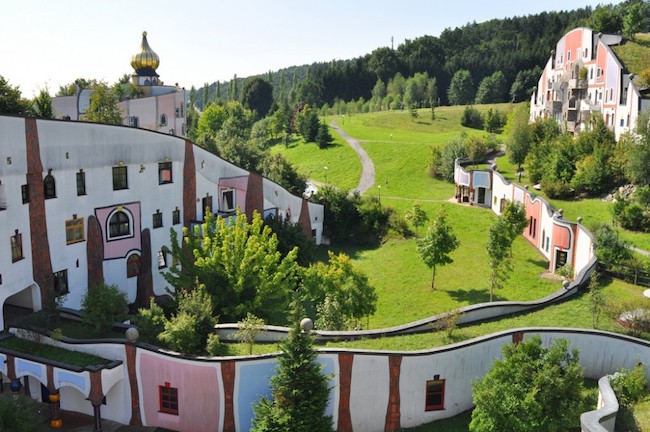Friedensreich Hundertwasser thought straight lines were souless, boring; he hated how they were the accepted thoughtlessly as the standard for architecture, confining human beings within inhuman boundaries.
Above image: The Rogner Bad Blumau spa, Austria, by Friedensreich Hundertwasser.
There’s two readings one can take from his stance: one was that Hundertwasser, born in 1928 in Vienna, was a proto-hippie. His full name, Friedensreich Regentag Dunkelbunt Hundertwasser (meaning, “Multi-Talented Peace-Filled Rainy Day Dark-Colored Hundred Waters” in German) would be evidence of that. His feverish manifestos, among which he argued for people to be comfortable with mold growing in their homes, would be more evidence.
But his personal background casts his anti-straight line stance in a different light. Hundertwasser and his mother were Jews living during the Second World War. He avoided notice by being baptized into the Catholic Church and he later joined the Hitler Youth.

The Rogner Bad Blumau Spa.
So of course he was disgusted with all things that resembled totalitarianism. Lines and rigid geometry were an uncomfortable reminder of the stultifying order he was subjected to as a child, a reminder of the brainless fascists goosestepping through Europe. When he made the jump from painting to architecture, his buildings took on the look of his psychedelic paintings and not a damn one of them used a straight line. Further, he believed that the occupant of apartment or a space in one of his buildings had the right to draw or paint anything they wanted on the exterior of a building that was within arm’s reach of a window.

Kunsthaus Abensberg, Abensberg, Germany.
When the curving buildings were paired with the ceramic cladding he favored, they became wholly unique. The bright colors and soft forms look as though Hundertwasser didn’t construct the building as much as he picked up a brush and painted it into the skyline. For being rigid structures, they suggest motion; some of his buildings look like they’d quiver like a cube of Jell-O if you poked them.
It deserves note that Hundertwasser was also an early advocate of environmentalism in architecture. The idea of mold being a part of someone’s daily living situation is a bit much, but several of the buildings pictured here use vegetation in pleasing ways. It’s a shame that Hundertwasser, who died in 2000, isn’t around to play with some of the newer ceramic tiles that clean pollutants from the atmosphere or encourage plants to grow vertically up the facade of a building.
Bill Rodgers is a Contributing Editor at CFile.
Any thoughts about this post? Share yours in the comment box below.

The Spittelau Incineration Plant in Vienna.

The Rogner Bad Blumau


Quixote Winery, Napa Valley, California.

Hundertwasserhaus in Vienna, Austria.

Rogner Bad Blumau









His Hundertwasser Haus in Vienna was one of the first, 1980, to advocate grass covered roofs.
I love these. The buildings you live and work in can have a huge impact on your state of mind and the way you live your life. however some architects view the buildings they design as art objects rather than functional places to make your life work better. (Frank Gehry for example).
I’d love to believe they work as well inside as they look outside but I suspect they don’t. I’d still like to see the interiors just in case.
Good design is kind. When you look around for what you need, there it is, just where you were hoping it would be. It makes you feel someone has cared for you, and we could do with more of that in today’s world.
Does anyone know how these columns were constructed?
Made in Italy
The town of Kawakawa in northern New Zealand is on the tourist map because of the Hundertwasser designed public toilets. Walls have wine bottles through them that allows light in and the broken tile sink fixtures scream Hundertwasser. interesting place.
The URINAL says it all…..
“Environment-friendly lifestyle feeds the essence of the ‘HUMAN SOUL. Living ialong with dead straight lines and within perfect cubic ‘Bauhaus boxes’ defeats the elements of ‘creation’ with which we are born.
Herewith my grammatical corrections:
“Living along dead straight lines…..